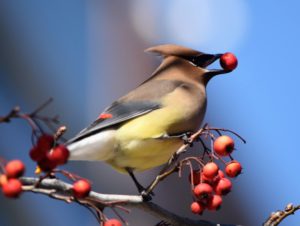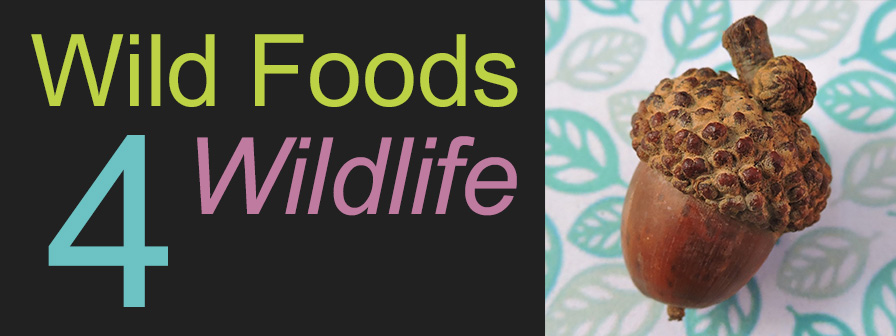Podcast:
Below is the link to a podcast of Kate talking with Gail Buhl, who works for Partners for Wildlife, housed at The Raptor Center at the University of Minnesota. The new podcast, Wildlife Rehabilitation – Rescue to Release, is dedicated to licensed wildlife rehabilitators and the veterinarians who support them to raise their animal welfare standards in their rehabilitation programs.
Listen to the podcast HERE!
Who Is This Site For?
Welcome! Thanks for checking out this site!
The purpose of this website is to assist permitted wildlife rehabilitators to acquire wild plant foods to feed to their wildlife patients by linking up with volunteer plant foragers. We hope to help beginner plant enthusiasts and foragers collect appropriate fruits, seeds, greens and nuts that are eaten by the Virginia wildlife that are commonly treated in rehabilitation.
Permitted rehabilitators are often interested in offering wild foods which the patients in their care are used to eating, but lack the time or skills to do the foraging and preparation themselves. Armed with this website plus an additional good identification guidebook, some motivation and a beginner level of familiarity with wild plants, volunteers can be recruited to collect wild plant foods for the rehabilitation effort. And the rehabber will be able to determine with confidence which animals and birds would most likely benefit from which foods. In addition, this site may be useful to naturalists, students or anyone looking for a resource to learn about how wildlife interface with wild plant foods.
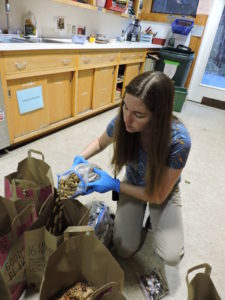
The Roots of this Website
The roots of this work go back to 2002 when I started as a volunteer at the Wildlife Center of Virginia, a wildlife hospital and rehabilitation center in the Shenandoah Valley of Virginia. Two years later I completed my first foray into learning about plants when I got my Master Herbalist Diploma through American College of Healthcare Sciences. And for the past 10 years, I have been studying and practicing wild plant foraging with the mentoring of the Kamana Naturalist Training Program at Wilderness Awareness School. Over that time, I also worked on staff for 5 years at the Wildlife Center of Virginia.
While working at the Wildlife Center of Virginia, I became interested in how I could help care for the animals, even though I was not working directly as a rehabber. So I started harvesting plants from my yard for the bunnies– those little, high-stress lagomorphs that had a lower survival rate in captivity. I wanted them to have to have some comfort foods to unwind. So I started collecting greens based on the the books I could find. Then I decided to start collecting seeds for the birds. Then nuts for the squirrels. I walked into work one day and handed my wild food to the rehabber and she looked happy, but perplexed. ” Aaaaand…who do I give these to?” she asked. I realized we had a problem.
All the books that listed the plants eaten by animals listed them by animal. What I needed was a listing by plant of which animals ate it. I realized that any wild food donations would be under-utilized or mis-utilized unless a rehabber could quickly determine which animals to give the food to by plant.
The seed for compiling this data and sorting the info in a new way was planted.
Why Feed Wild Foods?
It is well known that stress is a serious confounding factor in the recovery of injured wild animals in rehabilitation. Wild animals in captivity are subjected to unusual sounds, sights, temperatures, smells and the inability to escape from the proximity of humans while simultaneously having few of the comforts of the wild environment they are used to. All wild animals brought into rehabilitation are stressed by being captive, which compounds the stress of being injured or being separated from their parents.
For some animals and birds, the stress of captivity alone can contribute to their death. Offering foods that are familiar—comfort foods—can act to decrease stress for animals just as comfort foods do for humans. And if the same wild foods are offered as whole plant enrichment items, the animals gets the added benefit of engaging in relaxing, normalizing behaviors such as cracking nuts or gleaning seeds off plants.
Also, young animals and birds that are in the process of learning what to eat and how to forage can benefit from being offered some of the foods that will become lifelong staples to them once they return to the wild. The wild foods that a native ecosystem offers animals and birds are often exactly matched to what the animal has evolved to need nutritionally. While it is impractical to offer a wild food diet exclusively to animals in rehab, every little bit helps.
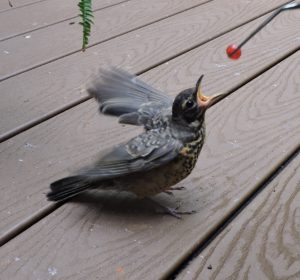
Food as Animal Enrichment
All wild animals find captivity to be very stressful. A stressed animal has more difficulty healing from its injuries or illness. Enrichment foods enrich quality of life. They are foods that stimulate the animal by providing more than just nutritional value, allowing the animal to engage in the foraging behaviors as it does in the wild. Gnawing nutshells to liberate the meat or scratching litter for seeds are normalizing behaviors which reduce stress.
Some plants are better suited to be used as enrichment foods than others. In the species monographs, I have included a short discussion of the benefits, uses or problems associated with some particular foods being offered as an enrichment item. Experimentation in this area to see what works is encouraged.
Usually, offering a wild food as an enrichment item means you do not process the food as much and instead allow the animal itself to do the work. For example, rather than picking the juniper berries off a red cedar, you might trim the whole branch and install it as a food-laden perch in the bird enclosure.
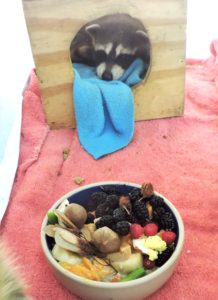
If You Feel “Plant-Stupid”
In the tradition I study and learn about plants—the Kamana Naturalist Training Program— they describe new students as often being intimidated by the “wall of green” they encounter as they start to learn plant species. It is true that something like 20,000 plant species grow in the U.S.A! We are fortunate to live in an extraordinarily diverse part of the world, and an even more diverse part of the United States. But that diversity can be very overwhelming when starting to learn plants. Just remember, even if a forager only supplies a rehabber with one well-known item like dandelion greens, that is a real help! In other words, we don’t have to be botanists to participate in this work.
Learning plants can feel like an exercise set up for failure. The average learner can figure out that they need to start to look for patterns of leaf shape, numbers of flower petals etc. But when they go to read about how to positively identify a plant, they are met with decision keys filled with neuron-killing technical language that I call “botanese.” While botanists do need a highly technical language to do their botanizing business, it is a real impediment to the amateur or new learner. I still struggle with this every time I crack open my Flora of Virginia. I have tried to include a list of accessible references that may help a new learner dip their big toe into the big world of plants and I will try to write in a manner that is as simple as I can muster.
That being said, positive ID is pretty darn essential, because we do not want to offer animals the wrong foods and possibly harm them. So the old Hippocratic oath of “do not harm” pertains here.
“If in doubt, leave it out.”
Stick to plants you are 100% sure of until your level of knowledge grows over time to include more. There are many plants listed at this site that I would not even think to try to collect—because I don’t know enough about them—yet. By the way, “botanese” gets easier over time. The first thing about botanical nomenclature you really do have to know, is written about under the tab Recommended Search Strategies and Plant Names ( Taxonomy).
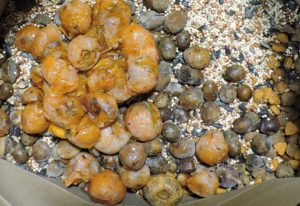
Positive Identification
This website is primarily a guide on how to harvest, prepare and store foods and which animals to give them to. It is not a comprehensive identification guide. You will need to get and use a good plant identification guide to identify any plants you harvest.
There are a lot of good wildflower and tree identification books out there. But I feel strongly that a great way to get started with Newcomb’s Wildflower Guide. I encourage all beginners to start with this wildflower book because it provides a systematic set of questions to help you zero in on likely plants to match what you are seeing. I like its method of flower identification by observing 1) a plant’s number of flower petals (parts), 2) the type of leaf arrangement on the stem and 3) the leaf type and then correlating those observations with the book’s key. It is well worth one’s time to learn how to use this key system in Newcomb’s Guide to Wildflowers to quickly and correctly identify a wildflower. There are lots of video’s online via a Google search that can give you a visual tutorial on using this book. The biggest drawback to Newcomb’s is that the plant has to be in flower.
Here are my top recommendations which have taken my learning journey far:
- Elpel, T.J. (2013). Botany in a Day (APG). Pony, Montana: Hops Press, LLC.
- Newcomb, L. (1977). Newcomb’s wildflower guide. Boston: Little, Brown and Company.
- Peterson, R.T., McKenny, M. (1968). Wildflowers: Northeastern/north-central North America. Boston: Houghton Mifflin Company.
- Petrides, G.A., (1958). A field guide to trees and shrubs. Boston: Houghton Mifflin Company.
- Virginia Department of Forestry (2009). Common Native Trees of Virginia: Tree Identification Guide. VDOF P00026.
- Virginia Department of Forestry (2014). Common Native Shrubs and Woody Vines of Virginia: Identification Guide. VDOF P00027.
Whatever guide you choose, read the book intro and familiarize yourself well with the system that particular guide uses to help you search through the book. It is tempting to skip it, but do not. I find it helpful to find good book that is just for my region or my state, which reduces the overwhelm of wading through lots of entries that aren’t even in my area.
There is a plethora of online identification resources. Here’s a few:
- Ladybird Johnson Wildflower Center
- Arbor Day Foundation Tree ID Guide
- Virginia Tech Tree Identification by Twig
- Go Botany
And here is a decent on-line botanical dictionary:
It is vitally important that you are certain of your identification, at least to the genus level for any plant you collect. While it is possible that adult mammals and birds will know which plants to avoid eating thereby catching any mistakes you make, you should never rely on that. Young animals may not have their instinct for safe vs. toxic food fully developed. Sick or injured animals cannot tolerate the added burden of a toxic food. In your foraging work, always take the bioethical Hippocratic oath: “First, do no harm.” It may be better to do nothing than to risk doing something that could cause harm to an animal.
For the plants I have written monographs for, I have included some descriptions of seeds and fruits, leaves and flowers to help you confirm an identification—a double check. If your seeds, fruits or nuts look significantly different than the photos or descriptors I have provided, stop and recheck your identification.
Lastly, You want to make sure you are collecting foods at the correct time. Immature fruits, nuts and seeds not only will not be as nutritious for the animals, but may be toxic in a way that the mature specimen will not be. Read how to tell if fruits and seed are ripe here.
